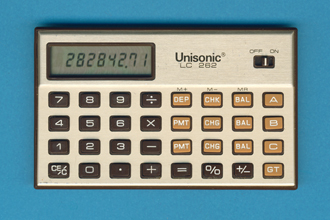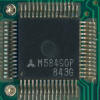
DATAMATH CALCULATOR MUSEUM
 |
DATAMATH CALCULATOR MUSEUM |
Unisonic LC 262
| Date of introduction: | 1979 | Display technology: | LCD |
| New price: | $39.99 (SRP June 1979) | Display size: | 8 |
| Size: | 2.2" x 3.6" x
0.30" 55 x 91 x 8 mm3 |
||
| Weight: | 1.5 ounces, 42 grams | Serial No: | 4872110 |
| Batteries: | 2*LR43 | Date of manufacture: | year 1979 |
| AC-Adapter: | Origin of manufacture: | Taiwan | |
| Precision: | 8 | Integrated circuits: | Mitsubishi M58490P |
| Memories: | 3 | ||
| Program steps: | Courtesy of: | Joerg Woerner | |
| Download manual: | |

![]()
 National Semiconductor introduced already in 1978 with the
NS103 Data Checker an electronic record keeper
with three continuous memories to track bank and charge account balances with
dedicated keys:
National Semiconductor introduced already in 1978 with the
NS103 Data Checker an electronic record keeper
with three continuous memories to track bank and charge account balances with
dedicated keys:
| • Memory 1 [CHK] [DEP] [BAL] [A] • Memory 2 [PMT] [CHG] [BAL] [B] • Memory 3 [PMT] [CHG] [BAL] [C] • Total sum of Memories [GT] |
While the NS103 Data Checker was based on proprietary technology, introduced NEC of Japan with the uPD1833G in 1980 a single-chip calculator circuit that created the blueprint for checkbook-sized Account Manager calculators and thereupon the market got swamped with products based on this design. The uPD1833G simplified the use of the memories by removing the redundant [A], [B], and [C] keys and replaced the inconvenient three-way power-switch of the NS103 Data Checker with two dedicated [ON] and [OFF] keys and a [DS] key to toggle between two entry modes:
| • Indicator (--) Floating decimal with manual insertion of the decimal using the [.] key • Indicator (AM) Add mode with the decimal automatically put in the dollars and cents position (0.00) |
Even the successor of the NS103, known as NS103A, switched its internals to the uPD1833G but we feature some more Account Manager calculators in the Datamath Calculator Museum based on this technology:
| • Canon
Checkbook - Missing the Toggle Key for the decimal mode • Royal LCB 841 - The Art of Perfection in Japan • Royal LCB 835 - Just one Memory (uPD1831G) • Texas Instruments TI-2200 Checkwriter - Late, but not too late • This Unisonic LC 262CK Check Master - Credit Card sized |
NEC of Japan lost some market share with their design for Account Manager calculators in the Eighties, when competitors like Hitachi and Sharp introduced similar chips and finally lost the business completely to Toshiba's "Solar Cells" compatible design. Find more Account Manager calculators in the Datamath Calculator Museum:
| • Canon
Checkbook II - Toshiba inside • Casio CB-80 - Hitachi inside • Unisonic LC 224CK Check Master - Sharp Inside • Texas Instruments TI-2200 II Checkwriter - Toshiba + Solar cells = Winning formula |

 Dismantling
the featured LC 262 manufactured in 1979 in Taiwan reveals a clean design
centered around a Mitsubishi M58490P single-chip calculator circuit
soldered on a double-sided printed circuit board (PCB) and powered by two
small LR43 batteries.
Dismantling
the featured LC 262 manufactured in 1979 in Taiwan reveals a clean design
centered around a Mitsubishi M58490P single-chip calculator circuit
soldered on a double-sided printed circuit board (PCB) and powered by two
small LR43 batteries.
 Inspecting the PCB of this
LC 262 manufactured in 1979 brought our attention to a small mark reading
203-3,
most likely a reference to Type 203 and Revision 3
of the design (schematics and layout).
Inspecting the PCB of this
LC 262 manufactured in 1979 brought our attention to a small mark reading
203-3,
most likely a reference to Type 203 and Revision 3
of the design (schematics and layout).
Please find an overview of the
PCB-Marks we discovered
so far on Account Manager calculators.
 Learn more about single-chip calculator circuits used in
Account
Manager Calculators.
Learn more about single-chip calculator circuits used in
Account
Manager Calculators.
Unisonic entered the market of Checkbook Calculators with the LC 262 in 1979. It features Account Manager functionality with three permanent (till you remove
the batteries) Memories and started a very successful product line. We discovered
as of now ten different family members:
| • 1979: This LC 262, 3 Memories, Credit Card size • 1981: LC 262CK, 3 Memories, Credit Card size • 1981: LC 263CK, 3 Memories • 1981: LC 224CK, 1 Memory • 1982: LC 224CKE, 1 Memory, Pen • 1983: LC 224CKM, 1 Memory, Pen • 1983: LC 223CK, 1 Memory, Credit Card size • 1985: LC 225CK, 1 Memory • 1987: LC 266CK, 3 Memories, Taiwan • 1988: LC 226CK, 1 Memory, Taiwan • 1990: LC 226CK, 1 Memory, Thailand |
Don't miss the Corvus CheckMaster introduced by Mostek already in 1975. This rare product retains the balance of your memory even when shut off but uses power-hungry electronics.
If you have additions to the above article please email: joerg@datamath.org.
© Joerg Woerner, February 13, 2020. No reprints without written permission.